(Updated April 2005 )
Vortex of Western History
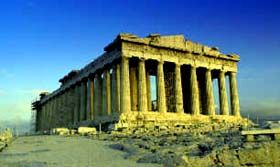 Athens must be the first port of call, if for no other reason than the Acropolis. You can read about it all your life, but when the Parthenon appears high on the Acropolis hill, both history and myth erupt into a sun-bright present tense of stunning marble architecture. The grace and massive grandeur of the temple is distinctly awe-inspiring and so deeply swathed in history and legend that it’s difficult not to be sentiently stirred at first encounter. The nobility of the edifice beautifully dominates the hill, the city, the country and indeed western civilization.
Athens must be the first port of call, if for no other reason than the Acropolis. You can read about it all your life, but when the Parthenon appears high on the Acropolis hill, both history and myth erupt into a sun-bright present tense of stunning marble architecture. The grace and massive grandeur of the temple is distinctly awe-inspiring and so deeply swathed in history and legend that it’s difficult not to be sentiently stirred at first encounter. The nobility of the edifice beautifully dominates the hill, the city, the country and indeed western civilization.
Aleki’s Island
(Note: Aleki’s Island ‘retired’ in 2004 but the owners have promised to open a new venue. I’ve left the story here because it was such a fine memory.)
After the sun sets and the great temple is swathed in sublime amber light, old town Athens becomes a glowing hive of cafes and aromatic restaurants. Not far from the picturesque mecca of Plaka district, there is a particular place much less renown than the Parthenon, but nevertheless revered by two generations of gay and lesbian Greeks. It is virtually a duty for knowledgeable visitors to pay regards to the venerable Aleko’s Island. We arrived just as it was opening at 10 PM.
The owners, Alexi and Jean-Pierre, greeted us like familiar old friends. For 27 years, they have been a couple, and for 20 of those years they have been the caring patrons of the ‘Island’. “I met him my very first night I arrived here from France,” Jean-Pierre exclaimed with still-buoyant Parisian enthusiasm. “He was zee first man I talked to–et viola, here we are.” Alexi laughs from behind the bar with a gently weathered face: “yes, and still he is in love with me. Those Frenchman are crazy!”
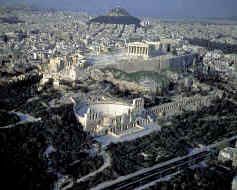 Before I can ask another question, Alexi, now in his fifties and JP in his forties, point us toward a plate of appetizers. “Try zeez”, JP urges. He delights in describing the grape leaves marinated in vinegar and stuffed with rice, onions and spices. It’s impossible to resist.
Before I can ask another question, Alexi, now in his fifties and JP in his forties, point us toward a plate of appetizers. “Try zeez”, JP urges. He delights in describing the grape leaves marinated in vinegar and stuffed with rice, onions and spices. It’s impossible to resist.
A few minutes later he arrives with a tray of chocolate brownies and places it next to a basket of fresh tangerines. Not long after, a plate of spinach rolls is offered to the early arrivals who show up dressed in an assortment of outfits from cowboy to Dracula drag (its’ Carnival week).
This is most unlike a bar. With real flickering candles and subdued lighting the Island feels more like Aleki’s and J-P’s living room than a place of commerce. The customers are older and younger, as more ‘friends’ arrive in tawdry drag, semi-leather, business attire or jeans and sport coats. They act more like family than customers and create a congenial ambiance. J-P told me yesterday they had an ‘army bear’ party–“for people to feel like a bear and dress like military, no?!” How can I disagree with the silliness of such an impish and charming host.
This is Athens’ mother of all gay bars, watched over by these two doting patrons gathering their flock for another evening of camaraderie. Here people can actually talk and hear each other above the easy Greco-pop music.
Greek Gay Venues
Athens is clearly Greece’s major gay location with 11 bars and clubs, 4 coffee shops, 4 adult theatres, 2 saunas, 2 gyms, 4 video clubs and one gay beach. There are also several political and social organizations, half a dozen publications and a network of activists and friends. (see Links)
 Another popular bar is Alexander’s disco. In contrast to Aleki’s, midnight here is early. A dark handsome bar tender shouts to me that the drag show does not start until 3 AM, his voice competing with the amplified throbs of George Michaels. There’s Greek music upstairs, high-energy Euro-disco downstairs and a wide variety of glistening boys and girls dancing till dawn–so we were told. The place was just barely starting to crank about 12:30 when we left. The night-morning crowd here is a younger set, in hip clothes (mostly tight black on black) sucking on cigarettes, chattering away (shouting) in the rich passionate tongue of Greek and not at all concerned with police interference. This is the new gay Greece: fearless, trendy, very European, brash, modestly prosperous, good looking and free.
Another popular bar is Alexander’s disco. In contrast to Aleki’s, midnight here is early. A dark handsome bar tender shouts to me that the drag show does not start until 3 AM, his voice competing with the amplified throbs of George Michaels. There’s Greek music upstairs, high-energy Euro-disco downstairs and a wide variety of glistening boys and girls dancing till dawn–so we were told. The place was just barely starting to crank about 12:30 when we left. The night-morning crowd here is a younger set, in hip clothes (mostly tight black on black) sucking on cigarettes, chattering away (shouting) in the rich passionate tongue of Greek and not at all concerned with police interference. This is the new gay Greece: fearless, trendy, very European, brash, modestly prosperous, good looking and free.
European Community and Human Rights
Subtlety yet discernibly, the tide is turning in favor of equal human rights since Greece joined the European Community. Membership commits EU countries to abide by certain legal codes standardized by the European Court of Justice, including the Court’s Human Rights policies which clearly state “equal treatment” for all citizens.
The ‘Code of Amsterdam’ is a set of guiding legal policies (not laws) adopted by the member EC countries. To their credit, member states have made noticeable, yet 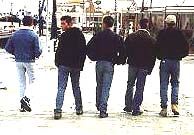 varying, efforts to align with these fundamental laws of justice. In Greece this has meant an easing of official attitudes toward homosexuality at the cost of strained resistance from the powerful Orthodox Church.
varying, efforts to align with these fundamental laws of justice. In Greece this has meant an easing of official attitudes toward homosexuality at the cost of strained resistance from the powerful Orthodox Church.
Nevertheless, same-sex consensual adult behavior is no longer a legal offence. Gay activism has become more evident in the past five years because there is now a safer political environment (read: we’ll leave you alone if you don’t make too much noise). Homophobic behavior is technically forbidden by these policies of the European Court of Justice. The age of consent for sex, gay or straight, is 15.
Yet there is a long way to go before the Greek government leaps forward to officially recognize same-sex domestic partnerships. Despite the bold and dignified leadership of the Scandinavian governments in offering state-sanctioned lesbigay unions, there is little talk about such marriage-equivalency here.
Traditionally, this macho and patriarchal society has been reinforced by Christian homophobia and public social prejudice. But it’s also well know that more than a few Greek men with a sex life worth bragging about have included at least one same-sex affair–as long as they convince others they were in the active role. It seems homoeroticism and homosexuality seethe just behind the conforming veneer of Greek heterosexual compliance.
In my opinion, perhaps nothing is more symbolic of this furtive sexuality than the countless post card reproductions and booklets of antique Greek vase drawings that depict copulation, cunnilingus and fellatio performed by men and women as well as by men and men. These cards are sold at virtually every newspaper kiosk across Greece with hardly a raised clerical eyebrow or teenage snicker.
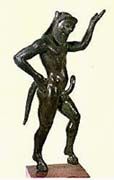 By far, the single most common post card to be seen in all of Greece, other than a blue-roofed white church, is a photo of a small eight-inch bronze statue on display in the dignified Archeological Museum in Athens. The image is of an “ithyphallic dancing satyr”, with an impish smile, sporting an oversize erection that launches nearly to his chest! The museum label merely describes it as a work from a Corinthian workshop of the second half of the 6th century BC.
By far, the single most common post card to be seen in all of Greece, other than a blue-roofed white church, is a photo of a small eight-inch bronze statue on display in the dignified Archeological Museum in Athens. The image is of an “ithyphallic dancing satyr”, with an impish smile, sporting an oversize erection that launches nearly to his chest! The museum label merely describes it as a work from a Corinthian workshop of the second half of the 6th century BC.
The post card makers have kept this particular card front and center everywhere, at small cigarette and candy kiosks, in small towns staffed by plump black-garbed widows across the square from Orthodox churches resounding with ponderous chanting. Often accompanying this card are several post cards of wide-bodied maidens in hiked-up bikinis, seen from behind, as they ‘pose’ on the beach.
Either the card makers or the kiosk vendors are making a good profit from these displays, or there is a less-than-subtle submergence being relayed about Greek desire. But there they are, the babes au derriere and the satyr in full bloom. No one seems to mind.
Orthodox Black
Covertly gay or overtly straight, Greek sexuality has always been muted by the indelible imprint of the Orthodox Catholic Church. This venerable and immovable institution is no friend of Gay Rights activists who work against the Church’s historic opprobrium that stoutly opposes the truth of homosexual feelings.
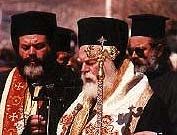 But the Church, like the Gay Movement, is finding that it has to exist and negotiate for its place in a changing world. I read in the English language newspaper ‘Kathimerini’ that the Orthodox leaders have reiterated their opposition to birth control and “deviant sexual behavior”. Yet in the same article, the clerics in somber black lamented the fall in church attendance and expressed their earnest hope that more people would follow the Church’s lessons for the ‘good life’.
But the Church, like the Gay Movement, is finding that it has to exist and negotiate for its place in a changing world. I read in the English language newspaper ‘Kathimerini’ that the Orthodox leaders have reiterated their opposition to birth control and “deviant sexual behavior”. Yet in the same article, the clerics in somber black lamented the fall in church attendance and expressed their earnest hope that more people would follow the Church’s lessons for the ‘good life’.
Fewer than 30% of the younger generation go to church regularly thinking it’s irrelevant to their lives. “There is no life in the church; I feel dull when I go inside. I don’t like the dark chambers and the boring chanting”, claimed one young man rolling his eyes when I asked him why he didn’t go to church. “Look at those silly monks and priests’, he said scornfully, “they dress like no one real. Why would I talk to a man in a black dress and a funny hat!” Unlike the nascent Gay movement, struggling for recognition and influence among the younger generations is a new problem for the Church.
Last Minute Cruise
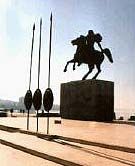 On the way home from Alexander’s, we accidentally passed another gay venue without knowing ahead of time it was there. As we walked next to the National Gardens at Zakro it was not hard to miss the universal and unmistakable body language of midnight strangers wandering the pathways among the foliage or lurking in provocative nocturnal poses on the benches. Despite the chilly night air, at midnight, these stalwarts attended their searchful watch for Mr. Right Now virtually across the street from the Presidential Palace. For these guys, the ithyphallic satyr was more of an active pursuit than a subtle hint; such nocturnal quests are more ancient than Greece itself.
On the way home from Alexander’s, we accidentally passed another gay venue without knowing ahead of time it was there. As we walked next to the National Gardens at Zakro it was not hard to miss the universal and unmistakable body language of midnight strangers wandering the pathways among the foliage or lurking in provocative nocturnal poses on the benches. Despite the chilly night air, at midnight, these stalwarts attended their searchful watch for Mr. Right Now virtually across the street from the Presidential Palace. For these guys, the ithyphallic satyr was more of an active pursuit than a subtle hint; such nocturnal quests are more ancient than Greece itself.
History
The history and territory of Greece is spread across a wide swath of beautifully rugged land hanging off the southeastern tail of Europe. From these rocky shores, fertile farmlands and strategic mercantile ports, the impudent and brilliant Alexander infused Greek culture across the known world to Asia before he died of an infection and, some say, a broken heart for the man he loved.
Our trail through the olive orchards and northern hills took us past Mount Olympus (not the same as Olympia where the games began) to the mainland city of Thessalonika. It would take a year or more to follow along the countless historical sites in this area known as Macedonia and Thrace. Here Alexander’s father King Philip was buried, his grave unmarked for millennia until the stunning 20th discovery of his great tomb. Here too, the stalwart visionary and preacher St. Paul brought his version of Christ’s teachings in what is surely one of the world’s most influential journeys of faith by a single person. In the ruins at nearby Philippi, the alleged actual dungeon can be seen where Paul was incarcerated for his disapproved teachings.
Reverence
East along the coast from Thessalonika, jutting like a finger out into the clear Aegean Sea, is a mountainous peninsula that is home to one of the most unusual communities in the modern world. Mount Athos is an ecclesiastical state within the domain of the Greek government. A hundred years ago it was granted autonomous status to govern itself and is now run by a council of abbots from the twenty Greek Orthodox monasteries built on the hills and cliffs during the past thousand years.
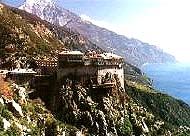 The monasteries are not accessible by overland road; the only way in is by boat to a couple of tiny ports along the ragged coastline along the thirty-mile peninsula. For centuries the devout monks refused any regular outside intrusion. Their spiritual life was their most closely guarded treasure. Today, a dozen monasteries are now open to ‘pilgrims’ while other abbeys still do not welcome any outsiders.
The monasteries are not accessible by overland road; the only way in is by boat to a couple of tiny ports along the ragged coastline along the thirty-mile peninsula. For centuries the devout monks refused any regular outside intrusion. Their spiritual life was their most closely guarded treasure. Today, a dozen monasteries are now open to ‘pilgrims’ while other abbeys still do not welcome any outsiders.
It’s hard to resist the convoluted effort to spend couple of nights a medieval stone fortress, which is what many of these sanctuaries resemble. Only ten foreign visitors a day are allowed passage to Athos. Greeks, on the other hand, enter by the dozens. Church starts at 4 AM (the first of several prayer times throughout the day) and breakfast is at seven. Attendees stand during the hours of chanting, but attendance is not required. After dinner at four-thirty PM the monks are in bed by eight and silence prevails.
During the social hour, usually about noon when guests arrive and others leave, I ventured a question to our guest master Brother Thomas (formerly from Mobil Oil in Manhattan) about homosexual attraction in the monastery. What happens if two monks fall in love or feel an attraction? Thomas seemed unruffled by the query and gently replied: “It would be a sin to be confessed, first. But since God is forgiving, the person would be forgiven.”
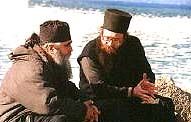 What would happen then? “Of course one or both of them would be asked to leave. It would distract from our community. We feel we are married to Christ first which is a marriage of the spirit. It would not be easy to remain faithful to the ‘calling’ and it would divert attention from our mission here.” He was calm and yet firm in his reply. I understood, of course, what he meant, but I couldn’t help thinking how odd it was that the love of one man for another has no place here in this temple of love for God. Was it God or man who works in mysterious ways?
What would happen then? “Of course one or both of them would be asked to leave. It would distract from our community. We feel we are married to Christ first which is a marriage of the spirit. It would not be easy to remain faithful to the ‘calling’ and it would divert attention from our mission here.” He was calm and yet firm in his reply. I understood, of course, what he meant, but I couldn’t help thinking how odd it was that the love of one man for another has no place here in this temple of love for God. Was it God or man who works in mysterious ways?
The Islands
Mykonos was our first island, easily accessed by ferry. The main port town is a labyrinth of winding alleys, walkways and narrow streets so one of the first experiences for most visitors is getting lost. But the walk is rendered enchanting by the visual charm of the white walls, tilted buildings and gray shadows accented with red, blue, green, or yellow doors, windows and balcony railings. It’s a visual feast worth getting lost in.
Some years ago the town elders wisely saw the potential in opening up to tourism and, as well, lesbigays knew an exotic ‘place in the sun’ when they saw it. 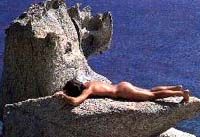 Today the laissez-faire attitude of the locals and the money of the tourists have combined to create an island of sun and fun. There are numerous villages and villas scattered around the island and a few nude beaches that have been exaggerated beyond their modest reality. The combination of crystal clear Aegean waters, warm summer sun, striking cubist architecture and the upbeat trendy venues in Mykonos town have increasingly attracted lesbigay travelers to this small island. The place easily and beautifully speaks for itself. Just don’t come in August when it’s overrun with northern Europeans, gay and straight, packing in a year’s ration of sunshine.
Today the laissez-faire attitude of the locals and the money of the tourists have combined to create an island of sun and fun. There are numerous villages and villas scattered around the island and a few nude beaches that have been exaggerated beyond their modest reality. The combination of crystal clear Aegean waters, warm summer sun, striking cubist architecture and the upbeat trendy venues in Mykonos town have increasingly attracted lesbigay travelers to this small island. The place easily and beautifully speaks for itself. Just don’t come in August when it’s overrun with northern Europeans, gay and straight, packing in a year’s ration of sunshine.
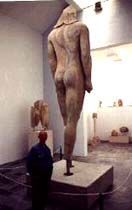 We arrived in early April along with a cold front that stormed into town and kept us ‘stranded’ for two days. The ferries do not run when the wind is up. The weather cleared and Mykonos became its cheerful sunlit self again as we left in search of a special place and a special gift from ancient Greece.
We arrived in early April along with a cold front that stormed into town and kept us ‘stranded’ for two days. The ferries do not run when the wind is up. The weather cleared and Mykonos became its cheerful sunlit self again as we left in search of a special place and a special gift from ancient Greece.
On the island of Samos, a six-hour ferry ride east of Mykonos, is the Archeology Museum in Samos town where artifacts from the 6th to the 3rd centuries BC are on display. The prize piece is the largest kouros ever found–a stunning fifteen-foot-tall marble statue of a nude male carved in the fourth century BC. This magnificent figure was only found in 1980, unearthed face down in a temple ruin a few kilometers away.
It’s one of those exquisite discoveries that make art, archeology and history worth every effort of research and digging. In detail and design the huge figure forcefully impresses upon the viewer the graceful power and forceful beauty the ancient Greeks found in the human form (unless you happened to be a slave). The statue has unusual vertical blue striations in the marble which give the figure an imperfection but which is also dramatic.
 And it was no accident that the sculptor, most likely in the fashion of Polycrates, ingeniously shaped the buttocks of the youth precisely around two circular striations. Aside from being aesthetically beautiful, the effect is both capriciously humorous and, perhaps not unintentionally, sensually appealing. (His butt looks like a target!)
And it was no accident that the sculptor, most likely in the fashion of Polycrates, ingeniously shaped the buttocks of the youth precisely around two circular striations. Aside from being aesthetically beautiful, the effect is both capriciously humorous and, perhaps not unintentionally, sensually appealing. (His butt looks like a target!)
Santorini
A few days later, after two more ferries and three islands, Santorini Island appeared on the horizon, jagged and erupted as it has appeared for three thousand years. Originally the island was shaped into the cone of a volcano. When it exploded around 1750 BC into the sky it was with a force and volume unknown in recorded time. So powerful that it led to the fall of the Minoan civilization on Crete over a hundred miles away to the south. During the eruption, the center of the volcano sank below the waters leaving a giant ring of sheer cliffs five miles across. Today white-painted towns have sprouted on the uppermost ridges of the rim looking much like snowcaps.
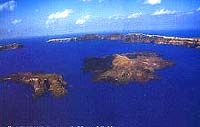 Living here today on the peaceful cliffs are James and Fannis, partners for 15 years who own and operate the Kavalari Hotel in the main town of Firi . Their bight-white cubist-shaped hostelry overlooks the dramatic thousand-foot drop into cobalt sea below. James came to Santorini from San Francisco looking for sun and ambiance; he found both, as well as Fannis, and he’s been here since.
Living here today on the peaceful cliffs are James and Fannis, partners for 15 years who own and operate the Kavalari Hotel in the main town of Firi . Their bight-white cubist-shaped hostelry overlooks the dramatic thousand-foot drop into cobalt sea below. James came to Santorini from San Francisco looking for sun and ambiance; he found both, as well as Fannis, and he’s been here since.
One balmy afternoon as we languished in the sublime beauty of the sea view, I posed a question to them. With a church or chapel at virtually every corner in Greece, how do such public sexual images as the girlie magazines and erotic postcards at the kiosks, along with copious sensual public advertising, fit with people in this conservative Orthodox milieu? Fannis replied that a lot of the influence comes from the rest of Europe and from America. Popular fashion, music, hair styling and films are very western here. “The real split in attitudes toward sex is the split between generations. Young people of the present generation are more relaxed about sexual ideas and advertising in public.”
So it must have been a young ad agent who designed the most sensual ad I’d seen in public: a billboard photo of a naked woman, breasts exposed, lounging on a chaise with a cigarette between her fingers. I imagined the cigarette company was not the only one delighted with the display!
Changing Attitudes
James reflected that changes had also come from Greece’s membership in the European Union with it modern ways of looking beyond one’s own culture. He agreed with me that EU membership has also brought a more open attitude about toward homosexuality in Greece.
Fannis agreed. Having lived in Santorini for most of his 48 years, he thought that Greek attitudes about homosexuality have migrated from ‘very bad’ to ‘accepting’. Born and raised on this island paradise, he has experienced a discernable shift in reactions over the past decade, even in his own family.
“I used to pretend I had a girlfriend but now James is here for 15 years, so they understand more; they know my truth and my love for him. Once my brother did not want us to bring his children here and I confronted him. He has changed a lot and now we have become all one family.”
James observed a change in the media as well, referring to a famous out-gay TV actor Georgos Marinos who portrayed a gay character in a live play in Athens, ‘Pink Strawberry’. In the play he falls in love with another man. The drama is about different kinds of love pairings in modern Greece.
There are now gay characters on Greek television especially, and not surprisingly, popular drag sitcoms and satires in which the roles are usually played by straight actors. Jame’s thought such roles are questionable as to their value in promoting openness or tolerance since they usually caricature gay men a ditsy-minded clowns, but Fannis felt it was a positive step in changing old thinking. “Laughter changes people; if they can laugh at something strange they will be less afraid”, he thoughtfully added.
In smaller towns like Firi attitudes are now more commonly in the form of ‘who cares’? Violent gay bashing is rarely heard of in Greece, even among people who still don’t like homosexuals. Any aggression, or verbal slurs like ‘pousti’ (nasty person) which Fannis heard as a young man, “come more from personal problems within” he said.
In Santorini, as in Mykonos, there has been an increase of gay international couples (one partner Greek, the other European or American) who socialize as a community of friends supporting each other with modern standards of pride and tolerance. Also, because of this international mix, James said, he no longer feels isolated as he did in his first three years.
After our chat, I paused for a while on the balcony looking out over the infinity of the sea. The sunset beauty of this place, the serenity of Santorini’s casual ambience, the intriguing crooked alleys of Firi punctuated with cafes, art galleries and pastry shops are all very seductive. This seemed a place where any gay person could live quite free from politics or homophobia.
More History
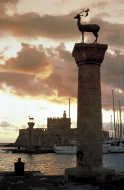 Our journey beyond Santorini took us south to the deep history of Crete and Rhodes. (See link for the gay-friendly Hotel Andres in Rhodes) In addition to the Lonely Planet Guide we drove around these ancient isles reading Will Durant’s The Life of Greece, a thick tome with myriad facts, names, statistics and daunting inside information about Greece’s ancient wars, slavery, social beliefs, politics, religion, race, as well as the fate of circumcised men.
Our journey beyond Santorini took us south to the deep history of Crete and Rhodes. (See link for the gay-friendly Hotel Andres in Rhodes) In addition to the Lonely Planet Guide we drove around these ancient isles reading Will Durant’s The Life of Greece, a thick tome with myriad facts, names, statistics and daunting inside information about Greece’s ancient wars, slavery, social beliefs, politics, religion, race, as well as the fate of circumcised men.
Egyptians, Selesians, Jews, Turks, Greeks, Macedonians–all took their turns at power only to get hacked back and imposed on. The Greeks, in one of their rages at the Jews, yanked down the trousers of men and boys and executed all the circumcised ones as well as their mothers. This was part of a ruthless determination to rid the Empire of Hebraics, chasidim and the ‘sons of Aron’ in the first century BC.
Blood and slaves, fine art and philosophers, beauteous sculpture and stunning architecture, gay lib and Orthodox dogma: the bad, the good and the ugly in the service of the tangled march of changing civilizations. Such was and is the soul of Greece–still not perfect, eternally mutable, and becoming a fine place to be gay or lesbian.
Also see:
Gay Greece News & Reports 20003 to present
Gay Greece Photo Galleries
















